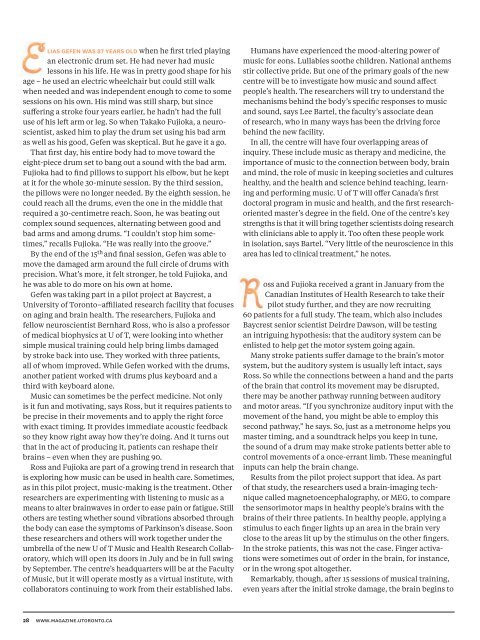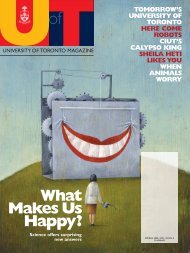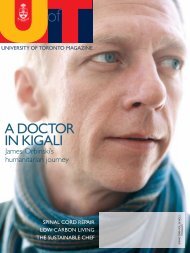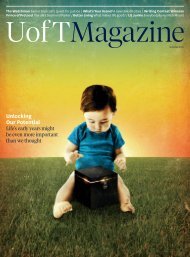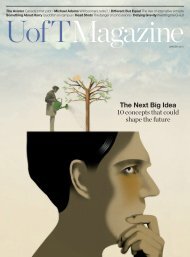What's the solution to Toronto's traffic problems? - University of ...
What's the solution to Toronto's traffic problems? - University of ...
What's the solution to Toronto's traffic problems? - University of ...
Create successful ePaper yourself
Turn your PDF publications into a flip-book with our unique Google optimized e-Paper software.
LIAS GEFEN WAS 87 YEARS OLD when he first tried playing<br />
an electronic drum set. He had never had music<br />
lessons in his life. He was in pretty good shape for his<br />
age – he used an electric wheelchair but could still walk<br />
when needed and was independent enough <strong>to</strong> come <strong>to</strong> some<br />
sessions on his own. His mind was still sharp, but since<br />
suffering a stroke four years earlier, he hadn’t had <strong>the</strong> full<br />
use <strong>of</strong> his left arm or leg. So when Takako Fujioka, a neuroscientist,<br />
asked him <strong>to</strong> play <strong>the</strong> drum set using his bad arm<br />
as well as his good, Gefen was skeptical. But he gave it a go.<br />
That first day, his entire body had <strong>to</strong> move <strong>to</strong>ward <strong>the</strong><br />
eight-piece drum set <strong>to</strong> bang out a sound with <strong>the</strong> bad arm.<br />
Fujioka had <strong>to</strong> find pillows <strong>to</strong> support his elbow, but he kept<br />
at it for <strong>the</strong> whole 30-minute session. By <strong>the</strong> third session,<br />
<strong>the</strong> pillows were no longer needed. By <strong>the</strong> eighth session, he<br />
could reach all <strong>the</strong> drums, even <strong>the</strong> one in <strong>the</strong> middle that<br />
required a 30-centimetre reach. Soon, he was beating out<br />
complex sound sequences, alternating between good and<br />
bad arms and among drums. “I couldn’t s<strong>to</strong>p him sometimes,”<br />
recalls Fujioka. “He was really in<strong>to</strong> <strong>the</strong> groove.”<br />
By <strong>the</strong> end <strong>of</strong> <strong>the</strong> 15 th and final session, Gefen was able <strong>to</strong><br />
move <strong>the</strong> damaged arm around <strong>the</strong> full circle <strong>of</strong> drums with<br />
precision. What’s more, it felt stronger, he <strong>to</strong>ld Fujioka, and<br />
he was able <strong>to</strong> do more on his own at home.<br />
Gefen was taking part in a pilot project at Baycrest, a<br />
<strong>University</strong> <strong>of</strong> Toron<strong>to</strong>–affiliated research facility that focuses<br />
on aging and brain health. The researchers, Fujioka and<br />
fellow neuroscientist Bernhard Ross, who is also a pr<strong>of</strong>essor<br />
<strong>of</strong> medical biophysics at U <strong>of</strong> T, were looking in<strong>to</strong> whe<strong>the</strong>r<br />
simple musical training could help bring limbs damaged<br />
by stroke back in<strong>to</strong> use. They worked with three patients,<br />
all <strong>of</strong> whom improved. While Gefen worked with <strong>the</strong> drums,<br />
ano<strong>the</strong>r patient worked with drums plus keyboard and a<br />
third with keyboard alone.<br />
Music can sometimes be <strong>the</strong> perfect medicine. Not only<br />
is it fun and motivating, says Ross, but it requires patients <strong>to</strong><br />
be precise in <strong>the</strong>ir movements and <strong>to</strong> apply <strong>the</strong> right force<br />
with exact timing. It provides immediate acoustic feedback<br />
so <strong>the</strong>y know right away how <strong>the</strong>y’re doing. And it turns out<br />
that in <strong>the</strong> act <strong>of</strong> producing it, patients can reshape <strong>the</strong>ir<br />
brains – even when <strong>the</strong>y are pushing 90.<br />
Ross and Fujioka are part <strong>of</strong> a growing trend in research that<br />
is exploring how music can be used in health care. Sometimes,<br />
as in this pilot project, music-making is <strong>the</strong> treatment. O<strong>the</strong>r<br />
researchers are experimenting with listening <strong>to</strong> music as a<br />
means <strong>to</strong> alter brainwaves in order <strong>to</strong> ease pain or fatigue. Still<br />
o<strong>the</strong>rs are testing whe<strong>the</strong>r sound vibrations absorbed through<br />
<strong>the</strong> body can ease <strong>the</strong> symp<strong>to</strong>ms <strong>of</strong> Parkinson’s disease. Soon<br />
<strong>the</strong>se researchers and o<strong>the</strong>rs will work <strong>to</strong>ge<strong>the</strong>r under <strong>the</strong><br />
umbrella <strong>of</strong> <strong>the</strong> new U <strong>of</strong> T Music and Health Research Collabora<strong>to</strong>ry,<br />
which will open its doors in July and be in full swing<br />
by September. The centre’s headquarters will be at <strong>the</strong> Faculty<br />
<strong>of</strong> Music, but it will operate mostly as a virtual institute, with<br />
collabora<strong>to</strong>rs continuing <strong>to</strong> work from <strong>the</strong>ir established labs.<br />
Humans have experienced <strong>the</strong> mood-altering power <strong>of</strong><br />
music for eons. Lullabies soo<strong>the</strong> children. National an<strong>the</strong>ms<br />
stir collective pride. But one <strong>of</strong> <strong>the</strong> primary goals <strong>of</strong> <strong>the</strong> new<br />
centre will be <strong>to</strong> investigate how music and sound affect<br />
people’s health. The researchers will try <strong>to</strong> understand <strong>the</strong><br />
mechanisms behind <strong>the</strong> body’s specific responses <strong>to</strong> music<br />
and sound, says Lee Bartel, <strong>the</strong> faculty’s associate dean<br />
<strong>of</strong> research, who in many ways has been <strong>the</strong> driving force<br />
behind <strong>the</strong> new facility.<br />
In all, <strong>the</strong> centre will have four overlapping areas <strong>of</strong><br />
inquiry. These include music as <strong>the</strong>rapy and medicine, <strong>the</strong><br />
importance <strong>of</strong> music <strong>to</strong> <strong>the</strong> connection between body, brain<br />
and mind, <strong>the</strong> role <strong>of</strong> music in keeping societies and cultures<br />
healthy, and <strong>the</strong> health and science behind teaching, learning<br />
and performing music. U <strong>of</strong> T will <strong>of</strong>fer Canada’s first<br />
doc<strong>to</strong>ral program in music and health, and <strong>the</strong> first researchoriented<br />
master’s degree in <strong>the</strong> field. One <strong>of</strong> <strong>the</strong> centre’s key<br />
strengths is that it will bring <strong>to</strong>ge<strong>the</strong>r scientists doing research<br />
with clinicians able <strong>to</strong> apply it. Too <strong>of</strong>ten <strong>the</strong>se people work<br />
in isolation, says Bartel. “Very little <strong>of</strong> <strong>the</strong> neuroscience in this<br />
area has led <strong>to</strong> clinical treatment,” he notes.<br />
oss and Fujioka received a grant in January from <strong>the</strong><br />
Canadian Institutes <strong>of</strong> Health Research <strong>to</strong> take <strong>the</strong>ir<br />
pilot study fur<strong>the</strong>r, and <strong>the</strong>y are now recruiting<br />
60 patients for a full study. The team, which also includes<br />
Baycrest senior scientist Deirdre Dawson, will be testing<br />
an intriguing hypo<strong>the</strong>sis: that <strong>the</strong> audi<strong>to</strong>ry system can be<br />
enlisted <strong>to</strong> help get <strong>the</strong> mo<strong>to</strong>r system going again.<br />
Many stroke patients suffer damage <strong>to</strong> <strong>the</strong> brain’s mo<strong>to</strong>r<br />
system, but <strong>the</strong> audi<strong>to</strong>ry system is usually left intact, says<br />
Ross. So while <strong>the</strong> connections between a hand and <strong>the</strong> parts<br />
<strong>of</strong> <strong>the</strong> brain that control its movement may be disrupted,<br />
<strong>the</strong>re may be ano<strong>the</strong>r pathway running between audi<strong>to</strong>ry<br />
and mo<strong>to</strong>r areas. “If you synchronize audi<strong>to</strong>ry input with <strong>the</strong><br />
movement <strong>of</strong> <strong>the</strong> hand, you might be able <strong>to</strong> employ this<br />
second pathway,” he says. So, just as a metronome helps you<br />
master timing, and a soundtrack helps you keep in tune,<br />
<strong>the</strong> sound <strong>of</strong> a drum may make stroke patients better able <strong>to</strong><br />
control movements <strong>of</strong> a once-errant limb. These meaningful<br />
inputs can help <strong>the</strong> brain change.<br />
Results from <strong>the</strong> pilot project support that idea. As part<br />
<strong>of</strong> that study, <strong>the</strong> researchers used a brain-imaging technique<br />
called magne<strong>to</strong>encephalography, or MEG, <strong>to</strong> compare<br />
<strong>the</strong> sensorimo<strong>to</strong>r maps in healthy people’s brains with <strong>the</strong><br />
brains <strong>of</strong> <strong>the</strong>ir three patients. In healthy people, applying a<br />
stimulus <strong>to</strong> each finger lights up an area in <strong>the</strong> brain very<br />
close <strong>to</strong> <strong>the</strong> areas lit up by <strong>the</strong> stimulus on <strong>the</strong> o<strong>the</strong>r fingers.<br />
In <strong>the</strong> stroke patients, this was not <strong>the</strong> case. Finger activations<br />
were sometimes out <strong>of</strong> order in <strong>the</strong> brain, for instance,<br />
or in <strong>the</strong> wrong spot al<strong>to</strong>ge<strong>the</strong>r.<br />
Remarkably, though, after 15 sessions <strong>of</strong> musical training,<br />
even years after <strong>the</strong> initial stroke damage, <strong>the</strong> brain begins <strong>to</strong><br />
28 www.magazine.u<strong>to</strong>ron<strong>to</strong>.ca


